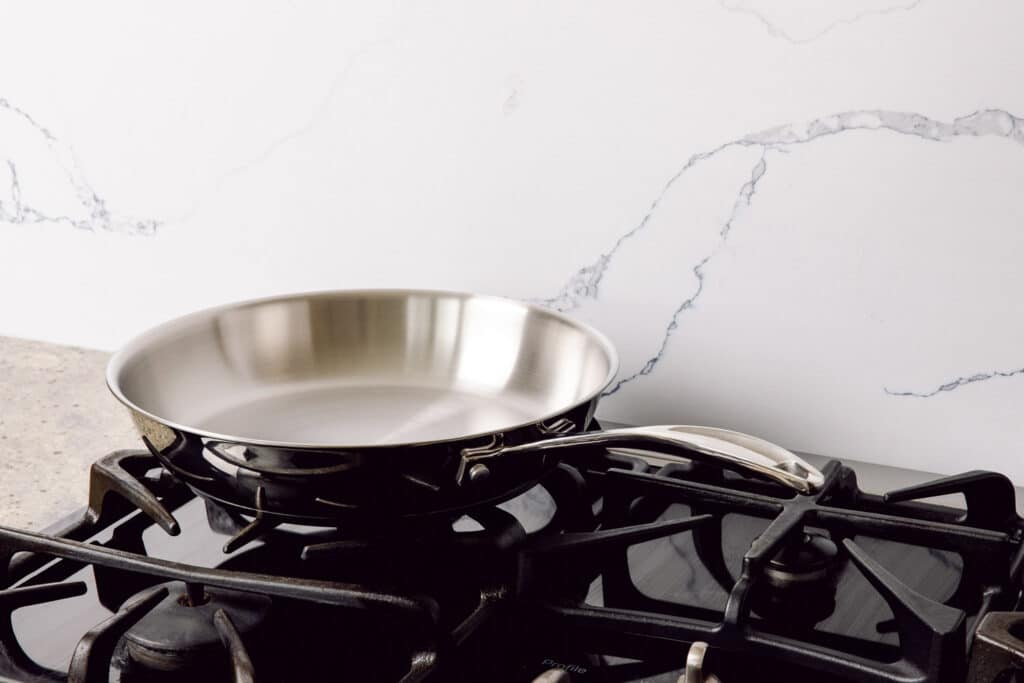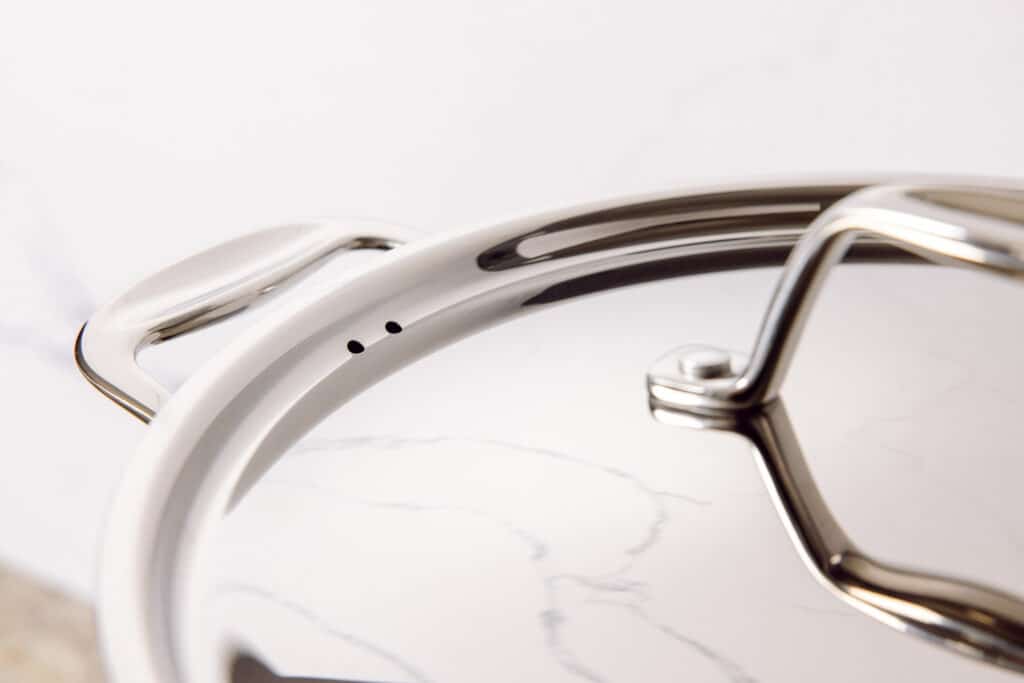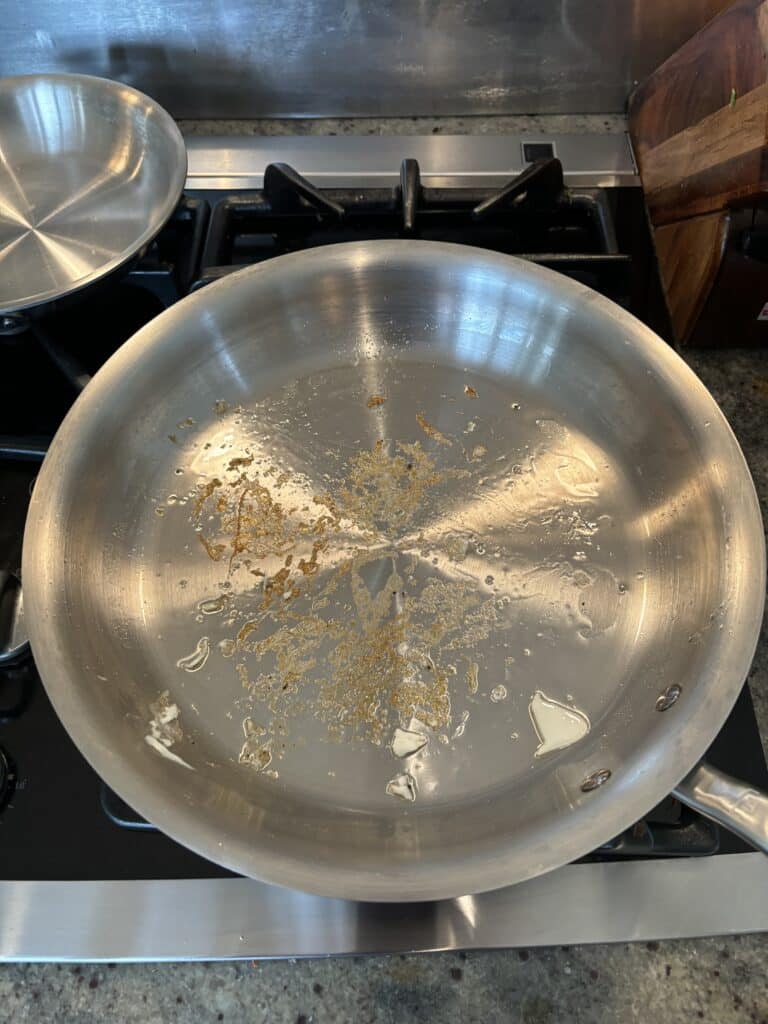Stainless steel is a great option for non-toxic, long-lasting, durable cookware ideal for boiling, sautéing, and baking. It is especially good for small-batch baking as it retains heat well and cooks foods evenly.

While I’m now a proud British-Canadian, I started out life in Sheffield, the Steel City. My grandfather worked in the steel rolling mill, and my grandmother worked for the city’s Master Cutler. Steel is in my blood, so it should come as no surprise that I’m a fan of stainless steel cookware. While there’s an element of nostalgia in my love for stainless steel, it’s also founded, ahem, in science. Why? Let’s look at the pros and cons of stainless steel in the kitchen.
Pros:
- Long-lasting and durable
- Retains heat well
- Cooks evenly
- Easy to clean and care for
- Typically dishwasher safe
Cons:
- May leach metals into food if cooking acidic foods for long periods of time
- Depending on the grade (specifically, amounts of nickel or manganese in the stainless steel) may be prone to corrosion
Disadvantages of stainless steel cookware
One possible downside of stainless steel is that it may leach heavy metals into food. This is more likely if you cook acidic foods in a stainless-steel pot for a long time. Stainless steel can contain iron, chromium, and nickel, the latter having no nutritional benefit in the body. Nickel has also been linked to adverse health effects, including sensitization to allergic (contact) dermatitis in some people (R).

Anyone who is nickel sensitive should consider an alternative to stainless steel. This is because, while stainless steel cookware is available that is either very low in nickel or nickel-free, such cookware is extremely prone to corrosion. Nickel is included in the stainless-steel alloy largely to help with rust resistance. It also helps increase the hardness of the stainless steel and gives it a polished look and feel.
In general, stainless steel consists of around 10 percent chromium, along with nickel and iron. Chromium also helps protect against rust and enhances durability. The ratio of nickel and chromium determines the ‘grade’ of stainless steel (find out more about steel grades through the British Stainless Steel Association, located, naturally, in Sheffield, England).
Cookware may be listed as 18/8, 18/10, or even 18/1, with the first number indicating the percentage of chromium and the second the percentage of nickel.
To make things even more confusing, stainless steel is also classified as being in the 200, 300, or 400 series. The 200 series has manganese in place of nickel, which makes cookware less expensive but more prone to corrosion. The 300 series (sometimes labeled as 304 or 316) is a higher quality range that is much more resistant to corrosion. Surgical grade steel is 316, for example, as the alloy contains some titanium and/or molybdenum to increase resistance to salt water (saline) erosion.
The cheapest stainless-steel cookware is usually in the 400 series. This alloy is more corrosive as it is almost entirely nickel-free. It is often found in mixing bowls, kitchen utensils, and cheap stockpots.
Free eBook: Simple Steps to a Greener Home
Concerned about climate change? Learn actionable tips for making each room in your home greener.
"*" indicates required fields

The benefits of stainless steel cookware
Stainless steel is a great option for non-toxic, long-lasting, durable cookware ideal for boiling, sautéing, and baking. It is especially good for small-batch baking as it retains heat well and cooks foods evenly.
Stainless steel is also easy to clean and care for, making it especially helpful for novice cooks, such as students living away from home for the first time. Just clean with hot soapy water after use, or scrub down with steel wool to remove any layers of oil that have accumulated.
Stainless steel is also a versatile material for cookware. You can easily find stainless steel pots and frying pans, as well as griddles, lasagna pans, roasting trays, muffin tins, and baking sheets.
One of the best options for stainless steel cookware is a 3-ply design layering stainless steel, aluminum, and stainless steel. This layering helps to seal in the aluminum – so you don’t need to worry about leaching – while harnessing aluminum’s better heat conductivity to produce a more homogenous cooking surface. This type of design is also easier to clean, dishwasher safe, and is sturdier and more polished than some cheaper cookware made purely with low-quality stainless steel. Made In stainless steel is manufactured with this type of 3-ply design.
How to season stainless steel cookware
One potential downside of stainless steel is that you typically need to use more oil to avoid food sticking to the pan. Learning to cook on a lower heat can help prevent food from sticking, but more advanced cooks might want to season their stainless steel to create a natural non-stick coating for frying pans or saucepans. To demonstrate the point, we have included video of frying an egg in our test cookware used to review the Italian brand, Made In. Even with a cap full of avocado oil, there is still some egg residue which sticks to the pan.

To season a stainless-steel pan:
- Heat the pan on a moderate heat and then add a generous amount of oil.
- Let the oil reach its smoking point, then turn off the burner and let the pan cool.
- Once the pan is cool, pour off the oil and wipe the pan clean
The surface of the pan should now be reflective and is seasoned to be non-stick. It will stay non-stick as long as the pan isn’t cleaned with soap. This is because when the pan heats, the metal expands. The oil then sticks to the surface as the pan cools and the metal contracts. A seasoned stainless-steel pan is great for cooking tofu scrambles, eggs, crepes, and similar dishes. Just don’t do what my grandfather did and cover the bottom of the pan with an inch of lard.
This is super helpful! Thank you so much!
Hi,
Am considering changing to steel cookware – your article is very helpful.
Thank you,
Thanks Allan!
Let us know what you end up buying and how it works out for you.
All the best,
Leigh
Heavy metals ‘leaching’ out of stainless steel? You’re talking absolute nonsense and nonscience 👎🏿🙁😎
Thanks for the comment, DB.
If you’re looking for some links to research, here are a couple of studies to read:
Study 1 – From the study: “After six hours of cooking, Ni and Cr concentrations in tomato sauce increased up to 26- and 7-fold respectively, depending on the grade of stainless steel.”
Study 2 – “Under common conditions, the use of 18/10 stainless steel pots is considered to be safe for the majority of nickel-allergic and/or chromium-allergic subjects. However, the total amount of nickel contained in foods and released from pots may exceed the individual threshold for triggering allergy, potentially causing problems for highly sensitive patients, or, conversely, contribute to induction of immunotolerance by oral low-dose exposure.”
Hope that helps,
Leigh
We seasoned as you said but on one of the pans there is a sticky residue? Any idea?
SS is always the best cookware IMO
Quite a interesting article it is, thanks for the share.
Great, informative and useful article. I didn’t know about 18/__, seasoning ss, and high acid corrosion. You made my next pan shopping excursion much easier. Thank you. Still cooking at 82.
I’m confused what is the best slow cooker to buy. I’m looking for a safe one to buy.
Marlene, here is our list of the best slow cookers that are PTFE free: https://www.leafscore.com/eco-friendly-kitchen-products/the-best-non-toxic-slow-cookers-plus-what-to-avoid/